Transformers in NLP
In this note book we will be look in very close details of the famous transformer as proposed in the paper Attention Is All You Need. To accompany the digestion, we will also be looking at how attention mechanism works in deep learning and finally implement transformer with transfer learning with FastAI library.

Contents
Overview: Current research trends, incentives of this repo, and our objectives
Model selection: Given so many high performance models, how do we choose which one to use?
Self-Attention: How the self-attention block works in deep learning architectures
Positional Encoding: Representing the order of the sequence using positional encoding
Residual connection: Residuals are implemented for better learning efficiency and loss convergence
Implementation: Implement transformer with transfer learning on IMDB sentiment analysis dataset
Overview
Jeremy Howard and Sebastian Ruder first introduced transfer learning with NLP in the ULMFiT paper and implemented the technique with the FastAI library.
For details of implementation of FastAI-NLP please refer to the fast.ai course or my two previous repos: ULMFiT-Sentiment-Analysis and Non-English-language-NLP.
In traditional NLP research, transfer learning was long reckoned as not applicable even after it’s great success in the computer vision research. For a long time, NLP was thought as special and needs to be treated with special care even when it comes to deep learning solution implementation. Hence, nobody published anything about transfer learning for NLP until Jeremy et al. proved to the crowd that “transfer learning is nothing specific to the computer vision domain” and this whole kicked off. The recent NLP academic trend has began to shift towards transfer learning as the time-saving and learning efficiency boost is quite obvious.
Big name companies has continued to push this technique further with transfer learning applied with more sophisticated architectures at larger scales: Google(BERT, Transformer-XL, XLNet), Facebook(RoBERTa, XLM) and OpenAI(GPT, GPT-2).
FastAI library itself comes only with AWS-LSTM, Transformer and Transformer-XL. If we want to implement more advanced models(such as BERT or RoBERTa) while still enjoy the fast-prototyping and massive optimization offered by FastAI, we need to learn to integrate the two.
More specifically, we are going integrate FastAI and the transformers library developed by Hugging Face, formerly known as pytorch-transformers and pytorch-pretrained-bert. Now this library contains over 40 state-of-the-art pre-trained NLP models which we simply can’t pass on. It also come with essential utilities such as tokenizer, optimizer and learning rate scheduler. However, in this repo, we will use most of utility functions from fastai library as it’s a bit more optimized.
Code Implementation
You will find three Jupyter notebooks in this repo. In the Transformer with no LM fine-tuning.ipynb we will implement transformer with FastAI library without fine-tuning the language model separately. This notebook follows strictly the guide provided by Maximilien Roberti. Details of his guide can be found both in his Medium post as well as Kaggle chanllange. (Thumbs up for Maximilien Roberti)
The reason why there exists a second notebook is because in Maximilien’s implementation he mainly replaced the AWD_LSTM model from FastAI by RoBERTa from Hugging Face. According to Jeremy’s ULMFiT paper, if we’d fine tuning the encoder of the RoBERTa model as a language model before constructing the classifier for sentiment analysis task the accuracy could be even better. Hence, in the Implement various Transformers with FastAI.ipynb you will find the complete code for building two separate databunch for both language model and classification task as well as how can we apply transfer learning with transformers while taking advantage of the convenience of FastAI toolkit.
Lastly, there is a new promising model coming out as I am creating this repository: ALBERT. Since the name is pretty cool(and it definitely has some attractive trait, see next section), let’s take it out for a spin. This model is also trained with FastAI library’s infrastructure and it is expected to out-perform RoBERTa as advertised in it’s original paper
To benchmark our result we will be using the classic IMDb sentiment analysis dataset. Following the standard ULMFiT approach, in the last repo, we were able to reach 94.7% accuracy which is slightly better than the state-of-the-art result in 2017 (94.1% accuracy). Now let’s challenge ourselves to push these results even further by implementing more advanced skills.
In this repository you will find everything you need to incorporate transformers as the base architecture when using the FastAI framework. I will also try to provide you with the essential explanations of why we would make those customizations so that when you choose a different architecture you can replicate the process.
Model_selection
BERT, GPT, GPT-2, Transformer-XL, XLNet, XLM, RoBERTa, DistilBERT, ALBERT, XLM-RoBERTa, ALBERT, the list goes on. There are so many good performing NLP models out there all available with pre-trained weight on huge datasets. I could be overwhelming to decide which model to use. While this repo focuses on the Transformer family, here is come quick tips towards choosing your model.
BERT is certainly outperforming several NLP models that was previously state-of-the-art. Its performance improvement is largely attributed to its bidirectional transformer using Masked Language Model. RoBERTa, DistilBERT and XLNet are three powerful models that are popularly used and their various versions are available in Hugging Face. RoBERTa is a retraining of BERT with 1000% more training data and stronger compute power. In addition, dynamic masking is used during training. DistilBERT trains similarly to BERT but it has only half the number of parameters by using a technique called distillation. DistilBERT is not necessary more accurate than its counterparts but it requires less time to train and it’s faster during inference time. XLNet is the heavy weight player, it’s trained with larger datasets with much stronger computing power and longer time (about 5 times more than BERT). Moreover, during training time, XLNet doesn’t adopt masked language model, unlike BERT/RoBERTa/DistilBERT/ALBERT, but uses permutation language modeling where all tokens are predicted but in random order. The benefit of this is that the model could potentially learn the dependencies between all words. (with masked language model, dependencies between masked words are lost) Lastly, ALBERT from Google is another new power player in town. As compared to its peers, ALBERT is famous for having outstanding performance with much less parameters. More specifically, the authors adopted factorized embedding parameterization to decompose large vocabulary embed matrix into two small matrices. In addition, cross-layer parameter sharing was used so that we don’t have to learn 11 bert-encoder weights (we only need update one). There is an update on inter-sentence coherence loss, however, ALBERT still uses MLM training.
Conclusion
BERT/RoBERTa are very good baseline models are should perform fairly well for most NLP tasks. XLNet’s permutation based training could potentially give us a performance boost but the fine-tuning and inference takes more time. If we want fast inference speed, go for DistilBERT. ALBERT offers fasted training as it has the smallest parameters to update considering same model scale.
Transformer Key Elements
Self-Attention
This is probably one of the most important concept to understand when come to learning Transformer.
Say that we want to translate this sentence to Chinese:
“The cat can’t jump onto the table because it’s too tall”
What does ‘it’ refers to in this sentence? Does it refer to the cat or the table? To human, this is such a simple question but not as simple to an algorithm.
At the high-level, Self-attention allows the algorithm to associate ‘it’ to ‘cat’. As the model processes each word (each position in the input sequence), self attention allows it to look at other positions in the input sequence for clues that can help lead to a better encoding for this word.
Self-attention: step one
The first step of calculating self-attention is to create three vectors from each of the encoder’s input vectors (this would be the embeddings of the words). Hence, we create a Query vector, a Key vector, and a Value vector for each word. These vectors are created by multiplying the embeddings by three matrices that we trained during the training process.

What are the “query”, “key”, and “value” vectors?
They’re abstractions that are useful for calculating and thinking about attention. Once you proceed with reading how attention is calculated below, you’ll know pretty much all you need to know about the role each of these vectors plays.
Self-attention: step two
With “query”, “key”, and “value”, we can compute a score for each word in the input sentence. The score determines how much focus to place on other parts of the input sentence as we encode a word at the given position.
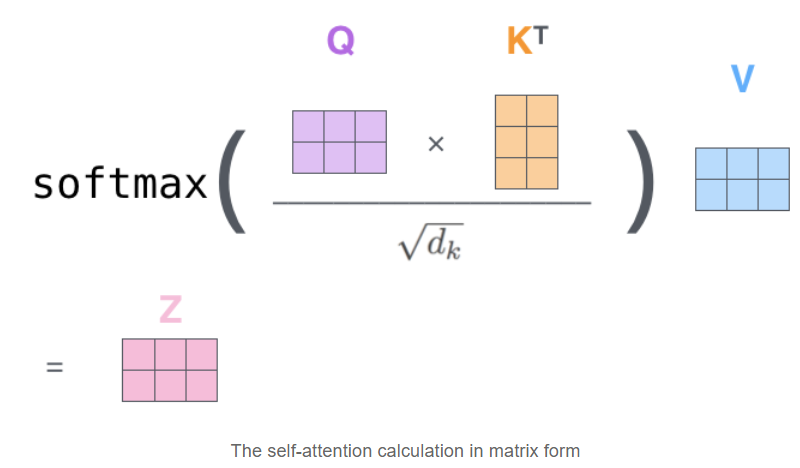
This “Z” score can be thought as to give us a score distribution that represents the attention the network has over all other word in the input sentence.
Multi-headed attention
This is another mechanism introduced by the authors to further improve the performance of the attention layers. It has mainly two effects:
- It expands the model’s ability to focus on different positions. Yes, in the example above, “Z” contains a little bit of every other encoding, but it could be dominated by the actual word itself (thanks to the softmax). It would be useful if we’re translating a sentence like “The cat can’t jump onto the table because it’s too tall” , when the algorithm knows what the word “it’s” is referring to.
- It give the attention layer multiple “representation subspaces”. As we will see for the illustration below, with multi-headed attention we have not only one, but multiple sets of Query/Key/Value weight matrices (the Transformer uses eight attention heads, so we end up with eight sets for each encoder/decoder). Each of these sets is randomly initialized. Then, after training, each set is used to project the input embeddings (or vectors from lower encoders/decoders) into a different representation subspace.
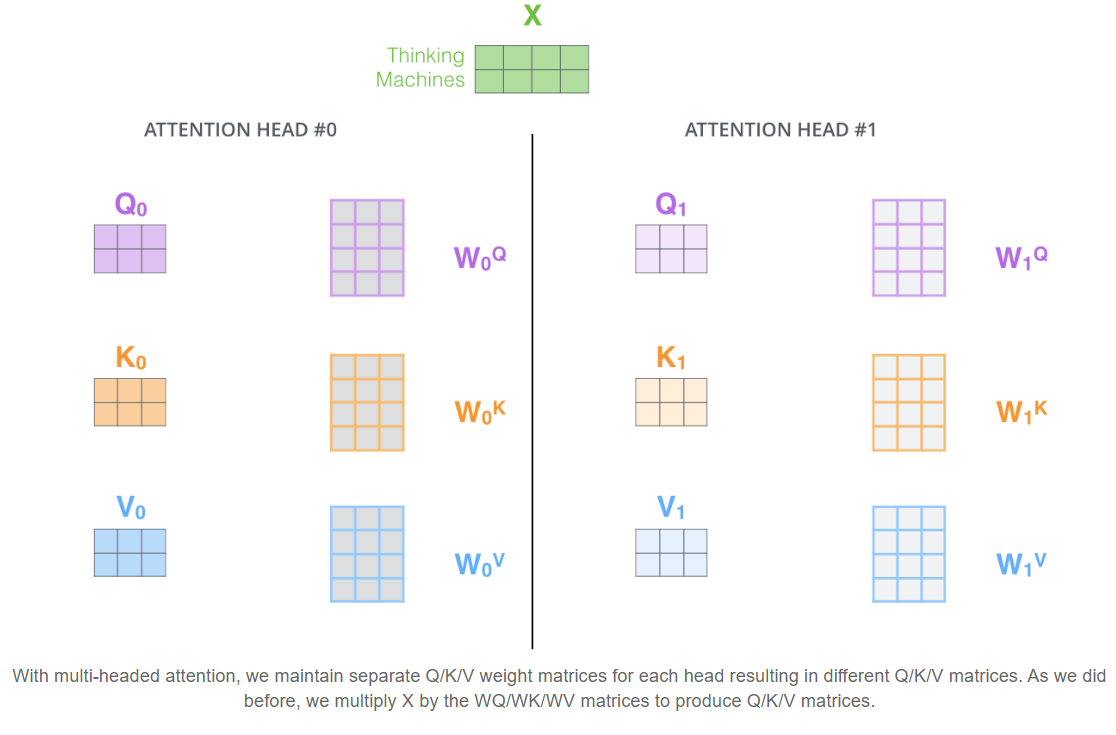
If we do the same self-attention calculation we outlined above, just eight different times with different weight matrices we end up with eight different “Z” matrices:
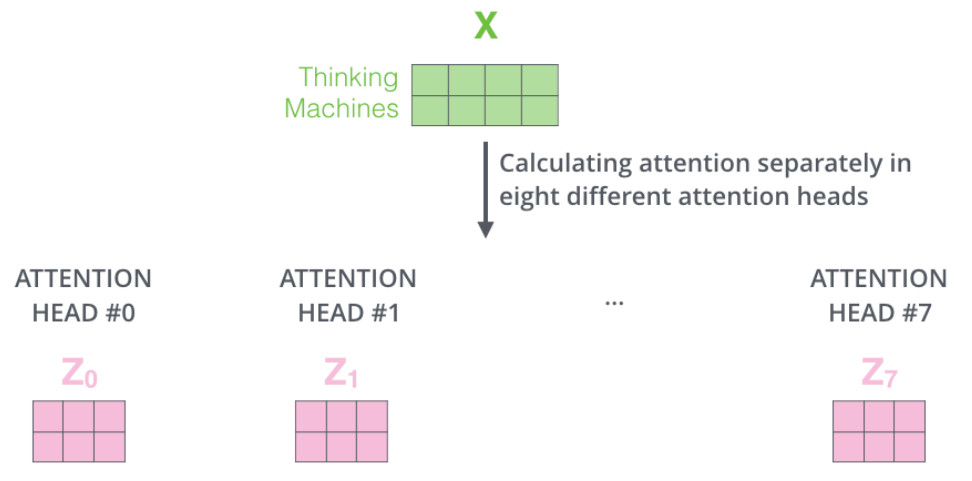
This leaves us with a bit of a challenge. The following layers is not expecting eight matrices — they are expecting a single matrix that contains a score for each word. So we need a way to condense these eight down to a single matrix. Solution: concatenate the matrices then use a another network to project it to the right shape:
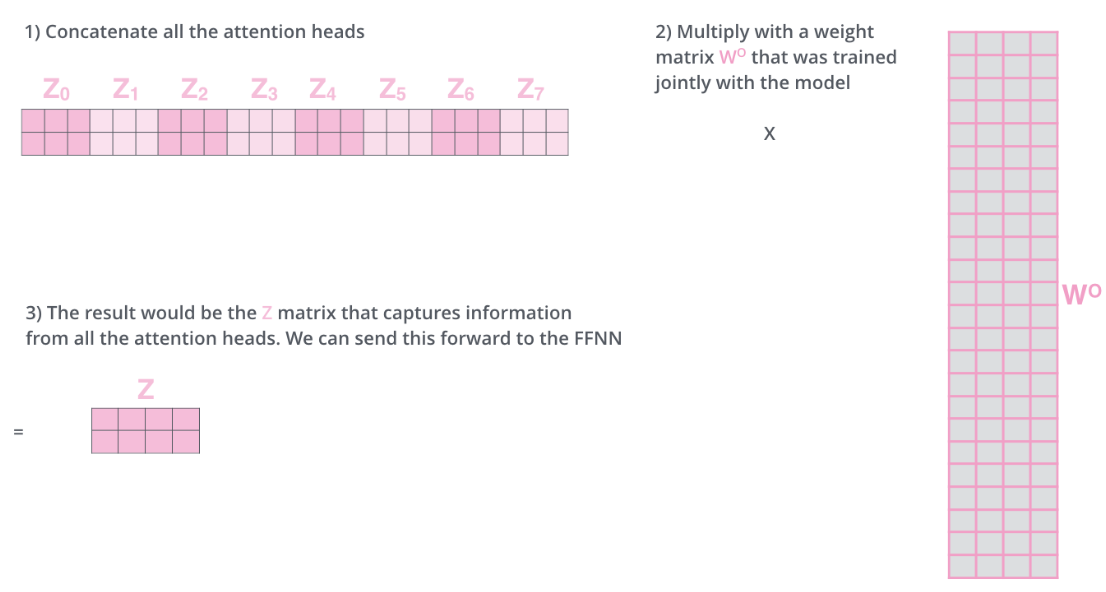
The overall picture of self-attention
Finally, when we put everything together.
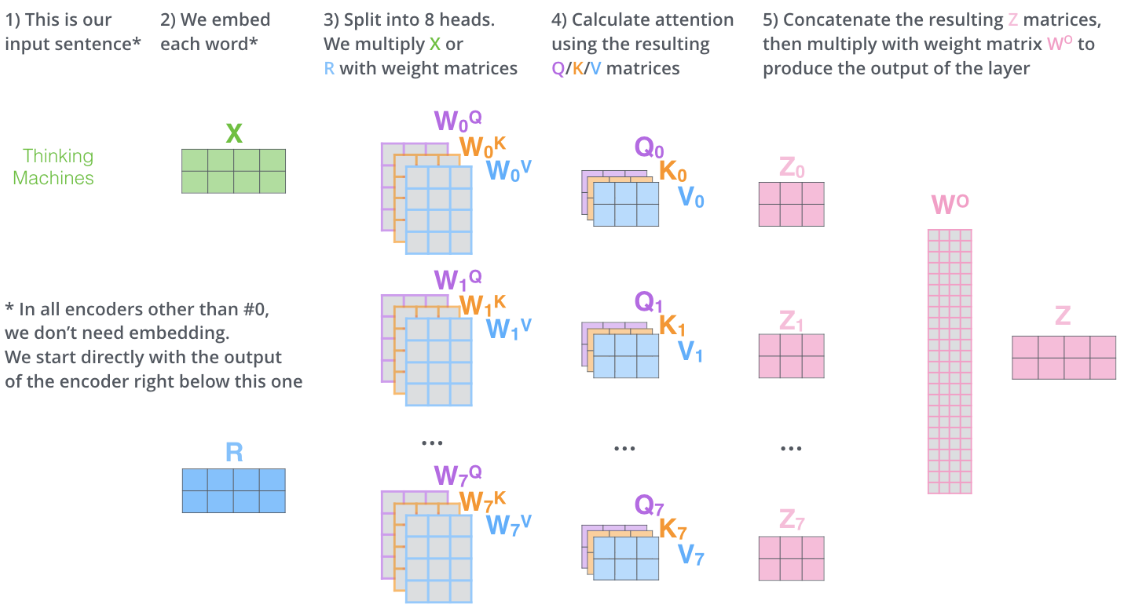
Positional_Encoding
One thing that’s missing from the model is the ability to locate the word’s position in the sentence.
To address this, the transformer adds a vector to each input embedding. These vectors follow a specific pattern that the model learns, which helps it determine the position of each word, or the distance between different words in the sequence. The intuition here is that adding these values to the embeddings provides meaningful distances between the embedding vectors once they’re projected into Q/K/V vectors and during dot-product attention.

If we assumed the embedding has a dimensionality of 4, the actual positional encodings would look like this:

Residuals
Similar to the ResNet, in the transformer’s encoder architecture there are residual connections. In each encoder, there is a residual connection around it, and is followed by a layer-normalization step. If we visualize the architecture is looks like this:
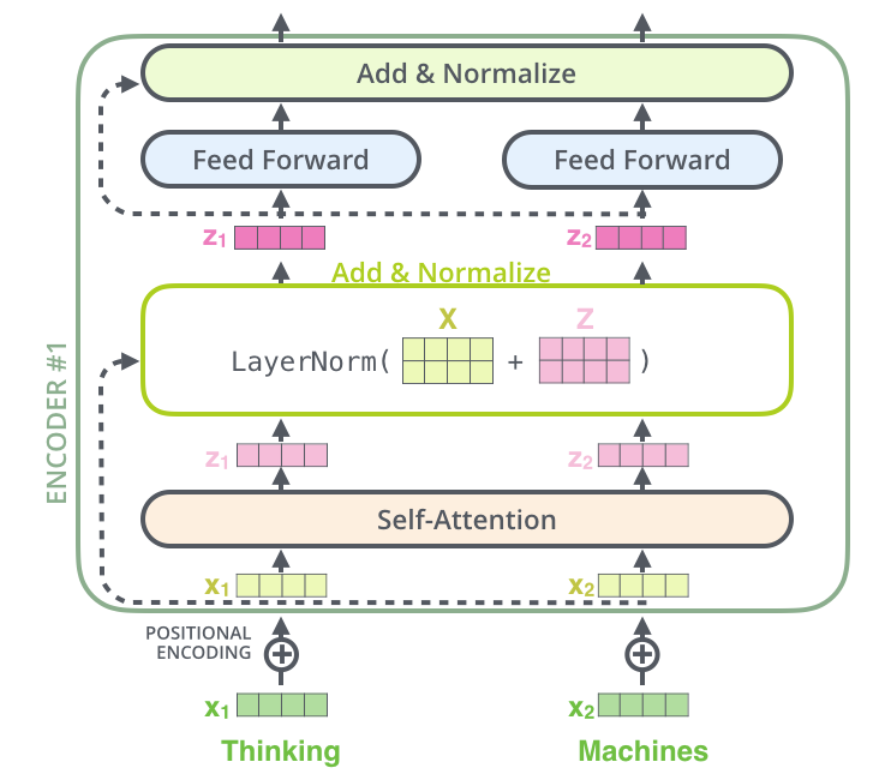
“X” vector is the positional encoding.
Overall_structure
Of course, the layers are stacked for the transformer. We have 6-layer-stacking for both encoder and decoder by the design of the original paper. For illustration, if have a transformer of 2-layer-stacking:

Code_Implementation
You will find two Jupyter notebooks in this repo. In the Transformer with no LM fine-tuning.ipynb we will implement transformer with FastAI library without fine-tuning the language model separately. This notebook follows strictly the guide provided by Maximilien Roberti. Details of his guide can be found both in his Medium post as well as Kaggle chanllange. (Thumbs up for Maximilien Roberti)
The reason why there exists a second notebook is because in Maximilien’s implementation he mainly replaced the AWD_LSTM model from FastAI by RoBERTa from Hugging Face. According to Jeremy’s ULMFiT paper, if we’d fine tuning the encoder of the RoBERTa model as a language model before constructing the classifier for sentiment analysis task the accuracy could be even better. Hence, in the Transformer training with Language model tuning.ipynb you will find the complete code for building two separate databunch for both language model and classification task as well as how can we apply transfer learning with transformers while taking advantage of the convenience of FastAI toolkit.
To benchmark our result we will be using the classic IMDb sentiment analysis dataset. Following the standard ULMFiT approach, in the last repo, we were able to reach 94.7% accuracy which is slightly better than the state-of-the-art result in 2017 (94.1% accuracy). Now let’s challenge ourselves to push these results even further by implementing more advanced skills.
In this repository you will find everything you need to incorporate transformers as the base architecture when using the FastAI framework. I will also try to provide you with the essential explanations of why we would make those customizations so that when you choose a different architecture you can replicate the process.
Walkthrough of 3 notebooks
RoBERTa without LM tuning: Training RoBERTa sequence classifier without fine-tuning the language model
RoBERTa with ULMFiT: Follow ULMFiT strategy by fine-tuning RoBERTa using Masked Language Modeling before training the actual sequence classifier
ALBERT: Fine tuning ALBERT for IMDb sentiment analysis
RoBERTa_without_LM_fine-tuning
When using the pre-trained models from transformer library, each model architecture need the following information:
- A model class to lead/store a particular pre-trained model.
- A tokenizer class to pre-process the data and make it compatible with our model of selection
- A configuration class to load/store the configuration of a particular model
We will start with the RoBERTa transformer from Facebook. To incorporate customized model with FastAI is not as simple as plugging in the model architecture into the Learner. We have to construct the proper dataloader(in FastAI known as databunch) so that the transformer is getting what its expecting to get.
Step.1 Customize our processors:
The important thing here is that FastAI uses processors to perform repetitive tasks when creating DataBunch. A set of default processors are performed for fastai.textlearners. For example:
# FastAI use various processors to perform repeatative tasks in data pipeline
def _get_processor(tokenizer:Tokenizer=None, vocab:Vocab=None, chunksize:int=10000, max_vocab:int=60000,
min_freq:int=2, mark_fields:bool=False, include_bos:bool=True, include_eos:bool=False):
return [TokenizeProcessor(tokenizer=tokenizer, chunksize=chunksize,
mark_fields=mark_fields, include_bos=include_bos, include_eos=include_eos),
NumericalizeProcessor(vocab=vocab, max_vocab=max_vocab, min_freq=min_freq)]
Here two default processors are invoked: tokenizer and numericalizer. The two classes are defined as such:
class TokenizeProcessor(PreProcessor):
"`PreProcessor` that tokenizes the texts in `ds`."
def __init__(self, ds:ItemList=None, tokenizer:Tokenizer=None, chunksize:int=10000,
mark_fields:bool=False, include_bos:bool=True, include_eos:bool=False):
self.tokenizer,self.chunksize,self.mark_fields = ifnone(tokenizer, Tokenizer()),chunksize,mark_fields
self.include_bos, self.include_eos = include_bos, include_eos
def process_one(self, item):
return self.tokenizer._process_all_1(_join_texts([item], self.mark_fields, self.include_bos, self.include_eos))[0]
def process(self, ds):
ds.items = _join_texts(ds.items, self.mark_fields, self.include_bos, self.include_eos)
tokens = []
for i in progress_bar(range(0,len(ds),self.chunksize), leave=False):
tokens += self.tokenizer.process_all(ds.items[i:i+self.chunksize])
ds.items = tokens
class NumericalizeProcessor(PreProcessor):
"`PreProcessor` that numericalizes the tokens in `ds`."
def __init__(self, ds:ItemList=None, vocab:Vocab=None, max_vocab:int=60000, min_freq:int=3):
vocab = ifnone(vocab, ds.vocab if ds is not None else None)
self.vocab,self.max_vocab,self.min_freq = vocab,max_vocab,min_freq
def process_one(self,item): return np.array(self.vocab.numericalize(item), dtype=np.int64)
def process(self, ds):
if self.vocab is None: self.vocab = Vocab.create(ds.items, self.max_vocab, self.min_freq)
ds.vocab = self.vocab
super().process(ds)
This is our IMDb text after tokenized with Fastai default tokenizer:

and this is IMDb text tokenized with transformer RoBERTa tokenizer:
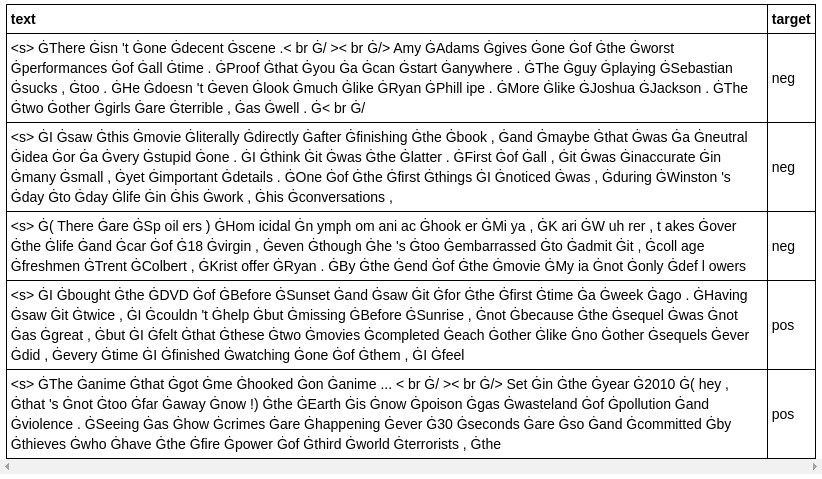
It’s easy to see that the Hugging Face RoBERTa is expecting different tokenization and that we need to customize the processors. What we need to do is essentially grab the tokenizer, vocabulary, special tokens and numericalizer from Hugging Face and put the FastAI wrapper on to make it a compatible class. Detail of these step please refer to the Jupyter notebook.
Step.2 Create Our DataBunch for classification:
We can easily find the IMDb dataset once we installed the FastAI library by calling untar_data(URLs.IMDb). This would return us a PosixPath object under which path we can find three useful files: train, test and unsup.
In this notebook, we are going to ignore the unsup folder and construct DataBunch only using train and test folders.
*Note that for transformer_processor we need to include OpenFileProcessor(). This is because we are reading from different folders instead of straight from dataframes or .csv files.
# processors need to be in the right order
transformer_processor = [OpenFileProcessor(),tokenize_processor, numericalize_processor]
Then create our DataBunch:
# we can play around with the batch_size as long as the GPU can take it
bs = 16
data_clas = (TextList.from_folder(path, vocab=transformer_vocab, processor=transformer_processor) # specify the path
.filter_by_folder(include=['train','test']) # exclude other folders
.split_by_folder(valid='test') # split by train and valid folder (that only keeps 'train' and 'test' so no need to filter)
.label_from_folder(classes=['neg', 'pos']) # label them all with their folders
.databunch(bs=bs)) # convert to databunch for the learner later
Step.3 Create our customized transformer model:
This step is quite straight forward. Get the model architecture itself provided by Hugging Face and make sure the forward function provides the right information.
# defining our model architecture
class CustomTransformerModel(nn.Module):
def __init__(self, transformer_model: PreTrainedModel):
super(CustomTransformerModel,self).__init__()
self.transformer = transformer_model
def forward(self, input_ids, attention_mask=None):
#attention_mask = (input_ids!=1).type(input_ids.type()) # Test attention_mask for RoBERTa
logits = self.transformer(input_ids,
attention_mask = attention_mask)[0]
return logits
# hyper parameter setup
config = config_class.from_pretrained(pretrained_model_name)
config.num_labels = 2
# Create customized transformer model
transformer_model = model_class.from_pretrained(pretrained_model_name, config = config)
custom_transformer_model = CustomTransformerModel(transformer_model = transformer_model)
Pay attention to what the forward function returns as we will be modifying this part once we get to the next notebook and start to build language models. We should also get the hyper-parameters provided by Hugging Face by calling config_class.from_pretrained(pretrained_model_name). Change the config.num_label = 2 as we only have positive or negative in IMDb prediction and then we are good to go.
Step.4 Create Learner object:
A DataBunch and a architecure are two object we must provide in order to create a Learner object in FastAI. There is one more thing we consider specify here that is our optimizer. FastAI uses AdamW by default and it was pointed out by Maximilien that for reproducing BertAdam specific behavior we have to set correct_bias = False. Hence we use the partial( ) function:
# customize AdamW
CustomAdamW = partial(AdamW, correct_bias=False)
# Create learner
learner = Learner(data_clas,
custom_transformer_model,
opt_func = CustomAdamW,
metrics=[accuracy, error_rate])
# Show graph of learner stats and metrics after each epoch.
learner.callbacks.append(ShowGraph(learner))
We are also going to split the layers. FastAI employs the concept of layer groups in that we divide our layers into a few groups so that later we have the freedom to freeze/unfreeze their weight or applier different learning rates for different layer groups.
# For roberta-base
list_layers = [learner.model.transformer.roberta.embeddings,
learner.model.transformer.roberta.encoder.layer[0],
learner.model.transformer.roberta.encoder.layer[1],
learner.model.transformer.roberta.encoder.layer[2],
learner.model.transformer.roberta.encoder.layer[3],
learner.model.transformer.roberta.encoder.layer[4],
learner.model.transformer.roberta.encoder.layer[5],
learner.model.transformer.roberta.encoder.layer[6],
learner.model.transformer.roberta.encoder.layer[7],
learner.model.transformer.roberta.encoder.layer[8],
learner.model.transformer.roberta.encoder.layer[9],
learner.model.transformer.roberta.encoder.layer[10],
learner.model.transformer.roberta.encoder.layer[11],
learner.model.transformer.roberta.pooler]
# use the defaul split function from Learner class
learner.split(list_layers)
Step.5 Training
Yeah! After all the hard work of setting things up, our favorite part of deep learning has come!
We are going to start with a frozen model by calling learner.freeze() , find the optimal learning rate learner.lr_find() and learner.recorder.plot(skip_end = 10, suggestion=True) and finally learner.fit_one_cycle() to do learning rate annealing.
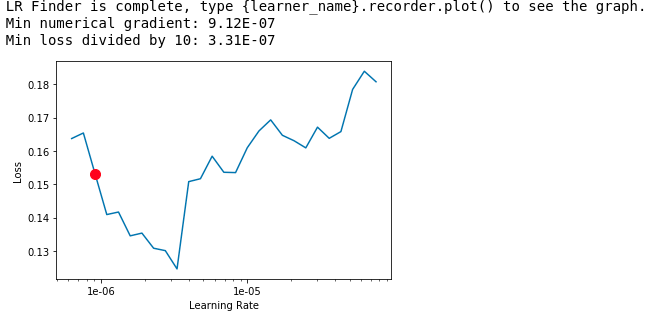
As suggested by Jeremy Howard in his ULMFiT paper we consider gradually unfreeze the layers 2 groups at a time, and repeat the above process.
We are able to achieve 95.3% accuracy which higher than the 94.1% (2017 state-of-the-art) and 94.7% ULMFiT with AWD_LSTM bacs architecture.

RoBERTa_ULMFiT
We have seen the the first notebook that by training a RoBERTa for sequence classification performs significantly better than the ULMFiT with AWD_LSTM. At point, we are naturally curious about what happens if we apply the ULMFiT training stratgy to the RoBERTa model. The “U” in ULMFiT stands for ‘universal’ anyway.
Don’t worry. You will find everything you need from fine-tuning language model to transfer learning to sequence classification in the second notebook. The code is heavily documented and I will also provide a walkthrough of the critical steps in the following section.
It’s important to notice that we can’t naively fine tune the RoBERTa language model the same way we dealt with AWD_LSTM. The reason is that, like all BERT model family, RoBERTa needs to be tune with masked language modeling in order cater to the bidirectional property of BERT. The essential change we have to make is that, instead training the text data in forward/backward direction (we do this with AWD_LSTM), we are going to mask 15% of labeling during fine tuning. This 15% ratio is per proprosed in the original paper and could be adjust by the RoBERTa_HP.mlm_probability in the code if so desire.
1. Create a new dataset just for language model fine tuning
When training the classifier for IMDb sentiment classification, we made use of the text files under both data/imdb/train as well as data/imdb/test and we have ignore all the text files in the data/imdb/unsup folder since they are not labelled. The good news is, now we can make use of the data/imbd/unsup folder since fine-tuning language model is an unsupervised task and we should gather all text we can put our hands on to make our RoBERTa language head more IMDb-like.
Objective: we want to grab all seperate .txt files under train, test and unsup folders into one single file. Randomly split it 90-10, so that we could use the 90% for training and 10% for evaluating our language model. Below is a simple piece of code that allows you do just that:
import random
# combine all the .txt files in the train/pos and train/neg folders
train_files = glob.glob(os.path.join((path/'train/*'),'*.txt'))
random.shuffle(train_files)
# split randomly 90% data to train_data_LM file and 10% to test_data_LM file
with open('train_data_LM.txt', 'ab') as outfile:
for f in train_files[:int(len(train_files)*0.9)]:
with open(f, 'rb') as infile:
outfile.write(infile.read())
with open('test_data_LM.txt', 'ab') as outfile:
for f in train_files[int(len(train_files)*0.9):]:
with open(f, 'rb') as infile:
outfile.write(infile.read())
Note that, this is just grabing all .txt files under data/imdb/train folder. You would want to do the same for data/imdb/test and data/imdb/unsup.
Take a look at the number of files in each folder, we would find that by simple including the unsup folder, we have efficiently doubled the size of our language model dataset.

2. Hyper-parameters for training
We will create a class casll training_param() and assign any training/hyper-parameters as it attibutes:
class training_param():
def __init__(self):
# general parameters
self.train_data_file = 'train_data_LM.txt' # train file name
self.eval_data_file = 'test_data_LM.txt' # test file name
self.model_name_or_path = 'roberta-base'# change this if using other models
self.block_size = 128 # The training dataset will be truncated in block of this size for training. Default to the model max input length for single sentence inputs (take into account special tokens)."
self.save_total_limit = 15 # total number of checkpoints we allow
self.output_dir = os.path.join(os.getcwd(),'fine_tuning_LM') # output directory for checkpoints and saves
self.train_batch_size = 4
self.eval_batch_size = 4
self.num_train_epochs = 4 # no. of epochs
self.logging_steps = 4000
self.save_steps = 4000
# optimizer parameters
self.learning_rate = 2e-5
self.weight_decay = 0.0
self.adam_epsilon = 1e-8
self.max_grad_norm = 1.0 # max gradient norm
self.warmup_steps = 0 # linear/cosine warmup over warmup_steps
# model parameters
self.fp16 = False
self.fp16_opt_level = 'O1' # For fp16: Apex AMP optimization level selected in ['O0', 'O1', 'O2', and 'O3']. See details at https://nvidia.github.io/apex/amp.html
self.mlm = True # Training with masked-language modeling loss instead of vanilla language modeling
self.mlm_probability = 0.15 # Ratio of tokens to mask for masked language modeling loss
self.device = torch.device("cuda" if torch.cuda.is_available() else "cpu")
# flags
self.evaluate_during_training = False # True to monitor training for each checkpoint saving, but this would time consuming
self.overwrite_cache = True
self.do_train = True
self.do_eval = True
self.do_lower_case = False # false to training RoBERTa model
self.overwrite_output_dir = True # overwrite the content of the output directory
self.no_cuda = False # Avoid using CUDA when it's available
self.eval_all_checkpoints = False # Evaluate all checkpoints starting with the same prefix as model_name_or_path ending and ending with step number
device = torch.device("cuda" if torch.cuda.is_available() else "cpu")
RoBERTa_HP = training_param()
The important things here is to point the train_data_file and the eval_data_file to the two files we created in our last step. Set your desired model architecture from HuggingFace/models.
Things to twick for better performance:
self.block_size # The training dataset will be truncated in block of this size for training. Size 128 was recommended by the paper for IMDb dataset. Maximum here is 512
self.num_train_epochs # Tunable for obvious reasons, usually tuned together with self.learning_rate
self.fp16 # NVIDIA's mix-precision training. There are papers reporting that mix-precision training sometime not only speed up the training process but also increase model performance
self.mlm_probability # tunable for different masking ratio but shouldn't be too far from 0.15
self.do_lower_case # always check HuggingFace documentation to see if this is an available choice for your model of choice
3. Create utility functions
To create PyTorch Dataset object with the right encoding:
class TextDataset(Dataset):
def __init__(self, tokenizer, HP, file_path="fine_tuning_LM", block_size=128):
assert os.path.isfile(file_path)
directory, filename = os.path.split(file_path)
cached_features_file = os.path.join(
directory, HP.model_name_or_path + "_cached_lm_" + str(block_size) + "_" + filename
)
if os.path.exists(cached_features_file) and not HP.overwrite_cache:
logger.info("Loading features from cached file %s", cached_features_file)
with open(cached_features_file, "rb") as handle:
self.examples = pickle.load(handle)
else:
logger.info("Creating features from dataset file at %s", directory)
self.examples = []
with open(file_path, encoding="utf-8") as f:
text = f.read()
tokenized_text = tokenizer.convert_tokens_to_ids(tokenizer.tokenize(text))
for i in range(0, len(tokenized_text) - block_size + 1, block_size): # Truncate in block of block_size
self.examples.append(tokenizer.build_inputs_with_special_tokens(tokenized_text[i : i + block_size]))
# Note that we are loosing the last truncated example here for the sake of simplicity (no padding)
# If your dataset is small, first you should loook for a bigger one :-) and second you
# can change this behavior by adding (model specific) padding.
logger.info("Saving features into cached file %s", cached_features_file)
with open(cached_features_file, "wb") as handle:
pickle.dump(self.examples, handle, protocol=pickle.HIGHEST_PROTOCOL)
def __len__(self):
return len(self.examples)
def __getitem__(self, item):
return torch.tensor(self.examples[item])
def load_and_cache_examples(HP, tokenizer, evaluate=False):
dataset = TextDataset(
tokenizer,
HP,
file_path=HP.eval_data_file if evaluate else HP.train_data_file,
block_size=HP.block_size,
)
return dataset
This is specific to BERT family model trainings.(If using XLNet, consifer permutation language modeling):
def mask_tokens(inputs: torch.Tensor, tokenizer: PreTrainedTokenizer, HP) -> Tuple[torch.Tensor, torch.Tensor]:
""" Prepare masked tokens inputs/labels for masked language modeling: 80% MASK, 10% random, 10% original. """
labels = inputs.clone()
# We sample a few tokens in each sequence for masked-LM training (with probability HP.mlm_probability defaults to 0.15 in Bert/RoBERTa)
probability_matrix = torch.full(labels.shape, HP.mlm_probability)
special_tokens_mask = [
tokenizer.get_special_tokens_mask(val, already_has_special_tokens=True) for val in labels.tolist()
]
probability_matrix.masked_fill_(torch.tensor(special_tokens_mask, dtype=torch.bool), value=0.0)
masked_indices = torch.bernoulli(probability_matrix).bool()
labels[~masked_indices] = -100 # We only compute loss on masked tokens
# 80% of the time, we replace masked input tokens with tokenizer.mask_token ([MASK])
indices_replaced = torch.bernoulli(torch.full(labels.shape, 0.8)).bool() & masked_indices
inputs[indices_replaced] = tokenizer.convert_tokens_to_ids(tokenizer.mask_token)
# 10% of the time, we replace masked input tokens with random word
indices_random = torch.bernoulli(torch.full(labels.shape, 0.5)).bool() & masked_indices & ~indices_replaced
random_words = torch.randint(len(tokenizer), labels.shape, dtype=torch.long)
inputs[indices_random] = random_words[indices_random]
# The rest of the time (10% of the time) we keep the masked input tokens unchanged
return inputs, labels
4. Create config , tokenizer, model and train it
Super simple steps to create our pre-trained models:
_, tokenizer_class, config_class , model_class = MODEL_CLASSES[model_type]
config = config_class.from_pretrained(RoBERTa_HP.model_name_or_path,
do_lower_case = RoBERTa_HP.do_lower_case)
tokenizer = tokenizer_class.from_pretrained(RoBERTa_HP.model_name_or_path,
do_lower_case = RoBERTa_HP.do_lower_case)
model = model_class.from_pretrained(
RoBERTa_HP.model_name_or_path,
config = config)
model.to(RoBERTa_HP.device);
5. Training the model and save its encoder
The training of the BERT family models are adopted from the HuggingFace finetuning. I have kept the essential elements required for this particular training and trimmed the excess code that we are not likely to use:
# The actual training/eval loops
if RoBERTa_HP.do_train:
global_step, tr_loss = train(RoBERTa_HP, train_dataset, model, tokenizer)
logger.info(" global_step = %s, average loss = %s", global_step, tr_loss)
# Create output directory if needed
if not os.path.exists(RoBERTa_HP.output_dir):
os.makedirs(RoBERTa_HP.output_dir)
logger.info("Saving model checkpoint to %s", RoBERTa_HP.output_dir)
# Save a trained model, configuration and tokenizer using `save_pretrained()`.
# They can then be reloaded using `from_pretrained()`
model_to_save = (
model.module if hasattr(model, "module") else model
) # Take care of distributed/parallel training
model_to_save.save_pretrained(RoBERTa_HP.output_dir)
tokenizer.save_pretrained(RoBERTa_HP.output_dir)
# Good practice: save your training arguments together with the trained model
torch.save(RoBERTa_HP, os.path.join(RoBERTa_HP.output_dir, "training_args.bin"))
# Load a trained model and vocabulary that you have fine-tuned
model = model_class.from_pretrained(RoBERTa_HP.output_dir)
tokenizer = tokenizer_class.from_pretrained(RoBERTa_HP.output_dir, do_lower_case=RoBERTa_HP.do_lower_case)
model.to(RoBERTa_HP.device)
results = {}
if RoBERTa_HP.do_eval:
checkpoints = [RoBERTa_HP.output_dir]
if RoBERTa_HP.eval_all_checkpoints:
checkpoints = list(
os.path.dirname(c) for c in sorted(glob.glob(RoBERTa_HP.output_dir + "/**/" + WEIGHTS_NAME, recursive=True))
)
logging.getLogger("transformers.modeling_utils").setLevel(logging.WARN) # Reduce logging
logger.info("Evaluate the following checkpoints: %s", checkpoints)
for checkpoint in checkpoints:
global_step = checkpoint.split("-")[-1] if len(checkpoints) > 1 else ""
prefix = checkpoint.split("/")[-1] if checkpoint.find("checkpoint") != -1 else ""
model = model_class.from_pretrained(checkpoint)
model.to(RoBERTa_HP.device)
result = evaluate(RoBERTa_HP, model, tokenizer, prefix=prefix)
result = dict((k + "_{}".format(global_step), v) for k, v in result.items())
results.update(result)
print(results)
Lastly step for language model fine-tuning, save the encoder of our model so that we can make use of it when we create our classifier later:
# get the model's encoder and save its weights
encoder = get_model(model).roberta
name = 'RoBERTa_encoder_IMDB'
torch.save(encoder.state_dict(), path/'models'/f'{name}.pth')
6. Create IMDb sentiment analysis classifer with fine-tuned encoder weights
The process of creating a FastAI Learner with Hugging Face tokenizer and numericalizer is similar to the previsou notebook, so I will omit the code here.
Create a new IMDb classifier after loading the weights from our previous encoder:
# This would only change the encoder weights
name = 'RoBERTa_encoder_IMDB'
custom_transformer_model.transformer.roberta.load_state_dict(torch.load(path/'models'/f'{name}.pth', map_location=None))
learner = Learner(data_clas,
custom_transformer_model,
opt_func = CustomAdamW,
metrics=[accuracy, error_rate])
7. Classifier final result
To recap the training process, we divided the model into 14 layer groups and gradually unfreezes bottom layers as top layer learns more reasonable weight to avoid catastrophic forgetting. (refer to the the second notebook for training details)
After unfreeze the entire architecture and fine-tune the model, we are able to obtain around 95.8% accuracy. It is not a sizable increment from 95.3% (with out LM fine-tuning). I actually repeated the training process 3 times with different LM fine-tuning hyper-parameters and I was able to consistently get good result. It’s safe to conclude that the ULMFiT process applied in RoBERTa is definitely beneficial.
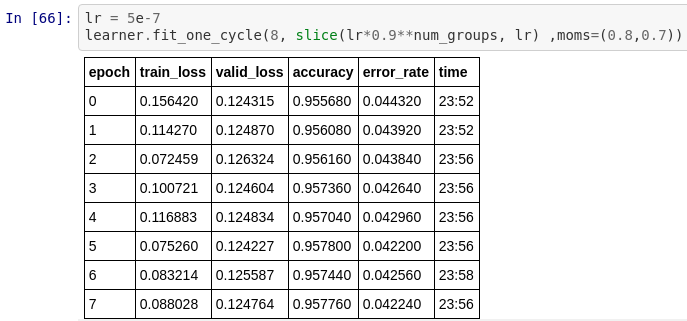
ALBERT
As I was creating this Transformer training series, a new model came out from Google(again) named ALBERT. Since the name is pretty cool and it was claimed in it’s original paper that it would outperform XLNet in the General Language Understanding Evaluation (GLUE) benchmark by significant margin, I’ve decided to add this third section to take ALBERT for a spin.
As compared to its peers, ALBERT is famous for having outstanding performance with much less parameters. More specifically, the authors adopted factorized embedding parameterization to decompose large vocabulary embed matrix into two small matrices. Instead of having a huge number of embedding parameters ($vocabulary\ size * hidden\ layer\ size$) we now have $(vocabulary\ sizeembed\ size + embed\ sizehidden\ layer\ size)$. This change has lead to a sizable parameter reduction given $E \ll H$ .
In addition, cross-layer parameter sharing was used so that we don’t have to learn 11 bert-encoder weights (we only need update one). More specifically, we have weight sharing in both feed-forward network and attention parameters. This change allows us to build much deeper networks without increasing the number of parameters significantly. There is an update on inter-sentence coherence loss, however, ALBERT still uses MLM training.